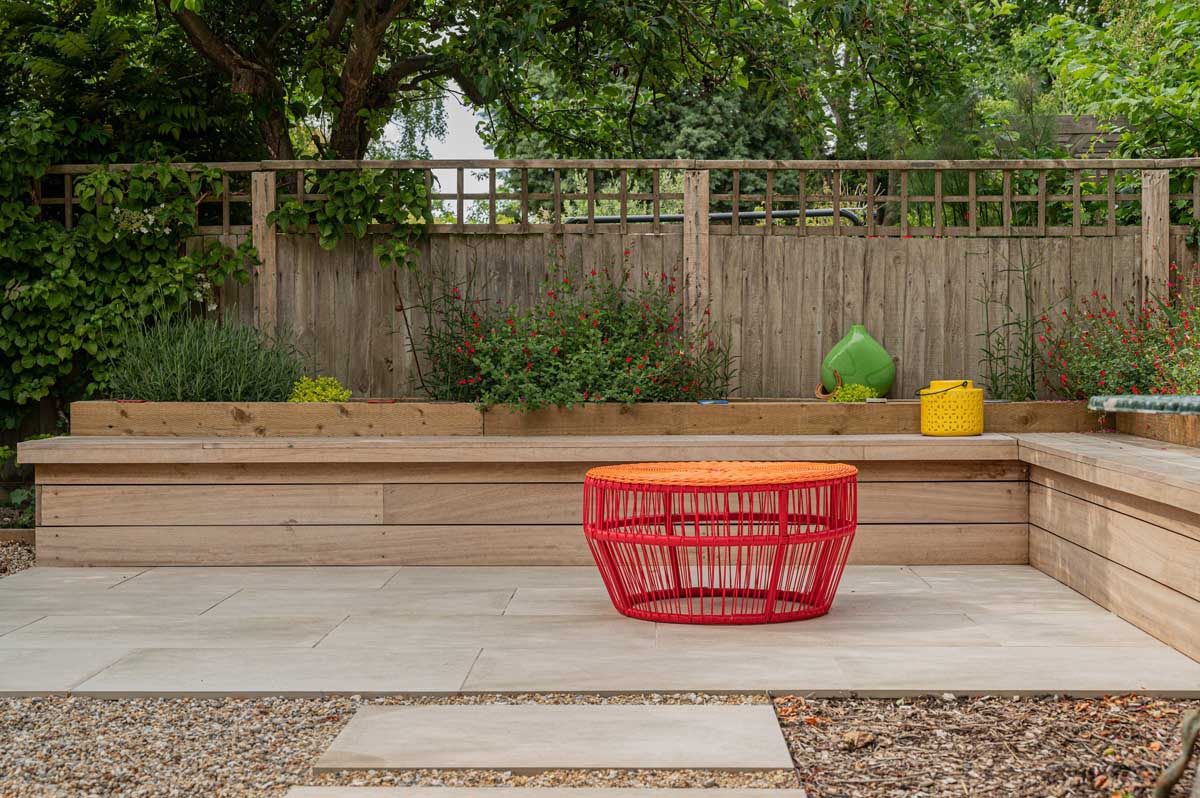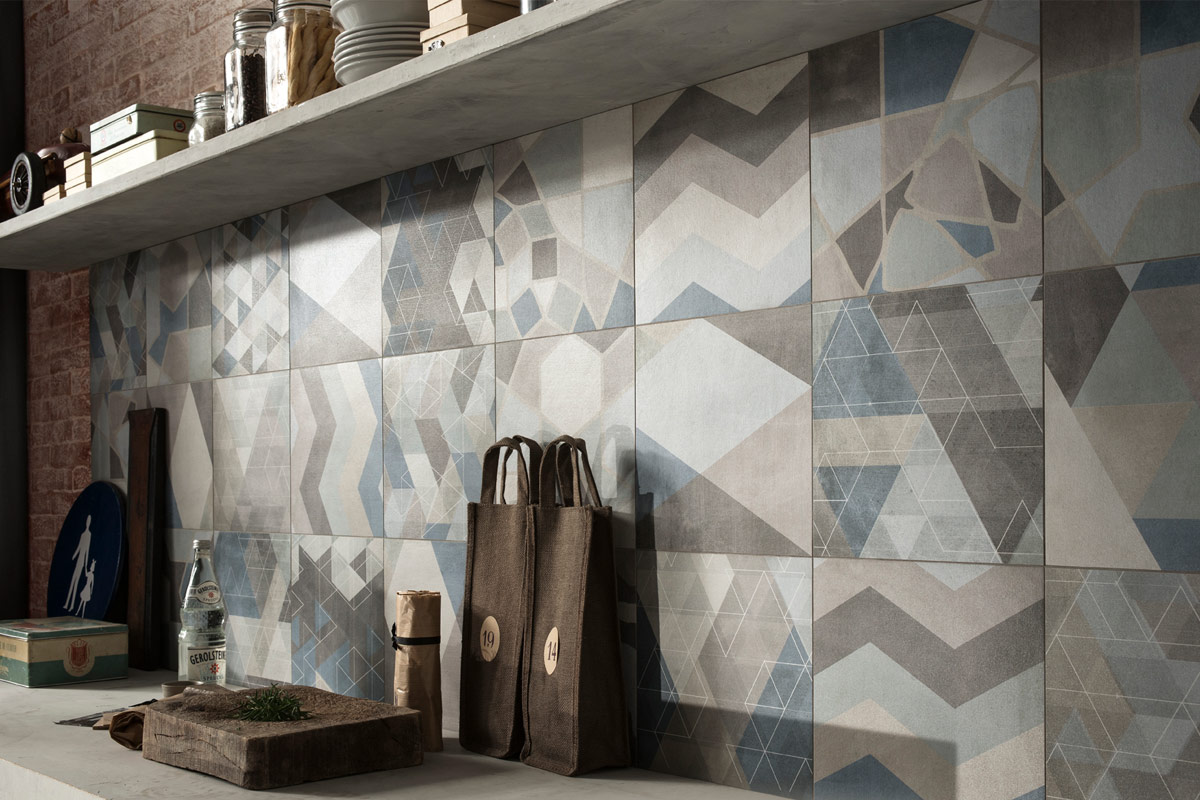If you're starting a new paving project and wondering how to cut porcelain slabs, you're in the right place. We give you specific points that will ensure you cut your porcelain paving correctly.

Porcelain is a fantastic material that has many benefits over natural stone, due to its ultra-low porosity. It’s ideal for both indoor and outdoor spaces, although its hard-wearing form can make it harder to cut.
Here we take you through the entire process of cutting porcelain paving..
If you still feel that you need more advice after reading through this page, please get in touch with our helpful team.
Cutting outdoor porcelain tiles: the first steps
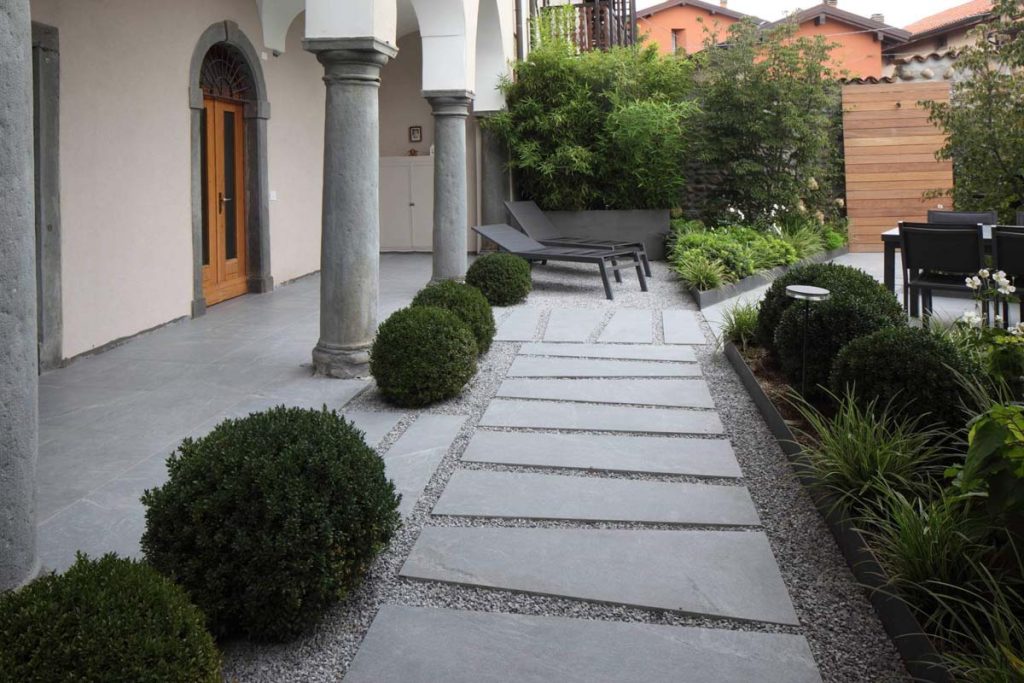
Before you get started with cutting porcelain, it's important to ensure you have the right cutting tools for the process. Being able to cut porcelain slabs accurately is a crucial part of making your project look good. Using the wrong blade to cut porcelain could result in the edges of your patio chipping, which will be detrimental to its appearance.
It's also important to take the necessary safety precautions before getting started, to avoid any accidents.
If you want to cut porcelain tiles, you'll need the following tools:
- Angle grinder OR wet tile saw
- Diamond blade
- Clamp
- Safety equipment (goggles, gloves, ear plugs and mask)
- Wax pencil and measuring paper
- Measuring tape
- Straight edge tool
- Rub brick or sandpaper
Depending on the particular cutting process you're going to follow, you may not need all these tools. However, it's a good idea to familiarise yourself with them and the procedure beforehand, so you can be as prepared as possible.
At London Stone, we sell a variety of cutting blades and tools - all you need to do is add your desired item to your basket and go through the easy instructions online.
How to cut porcelain slabs: our expert tips

There are two main ways to cut porcelain slabs - the one you choose will depend largely on your own preferences. Here we'll take a look at both methods, helping you to find the perfect one for your needs.
Whichever you choose, it's important to do a trial run before getting started, as this will help you get used to the blade and reduce the risk of any damage occurring.
Regardless of the type of tile-cutting tool you select, you also need to accurately measure the area you intend to lay beforehand. You'll need to determine the number of tiles you require and identify any that will be placed into curved spaces. Consistent gaps should also be allocated between your tiles for grouting.
You should then mark off the area of your porcelain slabs that you want to cut off with a wax pencil, using a straight edge tool to ensure accuracy.
Next, let's take a look at the two most common forms of porcelain tile cutting.
The wet tile saw technique
One of the most popular ways to cut your porcelain outdoor tiles is through the use of a wet tile saw. This often allows you to achieve the best possible cut. As the name of the tool suggests, a wet tile saw uses water as a lubricant, repelling dust and enabling you to make smooth cuts with a consistent appearance.
When using a wet tile saw to cut outdoor tiles, you first need to fill the device with clean water. When you start the blade up, the water will automatically pass through the machine and onto the tile. All you need to do is gently pass the blade over the line to cut on each tile, and you'll have your new set of porcelain slabs in no time.
Using a wet tile saw for the first time may seem scary, but these devices are often preferred by landscape contractors, as they are known for producing cleaner cuts in a relatively short time.
The angle grinder process
The second main option for cutting outdoor porcelain tiles is to use an angle grinder. Angle grinders are popular within the landscaping world, as they are small, easy to handle and, unlike a wet tile saw, relatively inexpensive. Whichever method of cutting you intend to use, we recommend using a continuous rim diamond blade. See information on blade choice below.
Firstly, your diamond blade needs to be safely fitted to your angle grinder. If your blade is even slightly loose, it can be dangerous and may also lead to your slabs cracking. The porcelain tile should also be placed securely so that it can't move during cutting.
Choosing which diamond blade to use
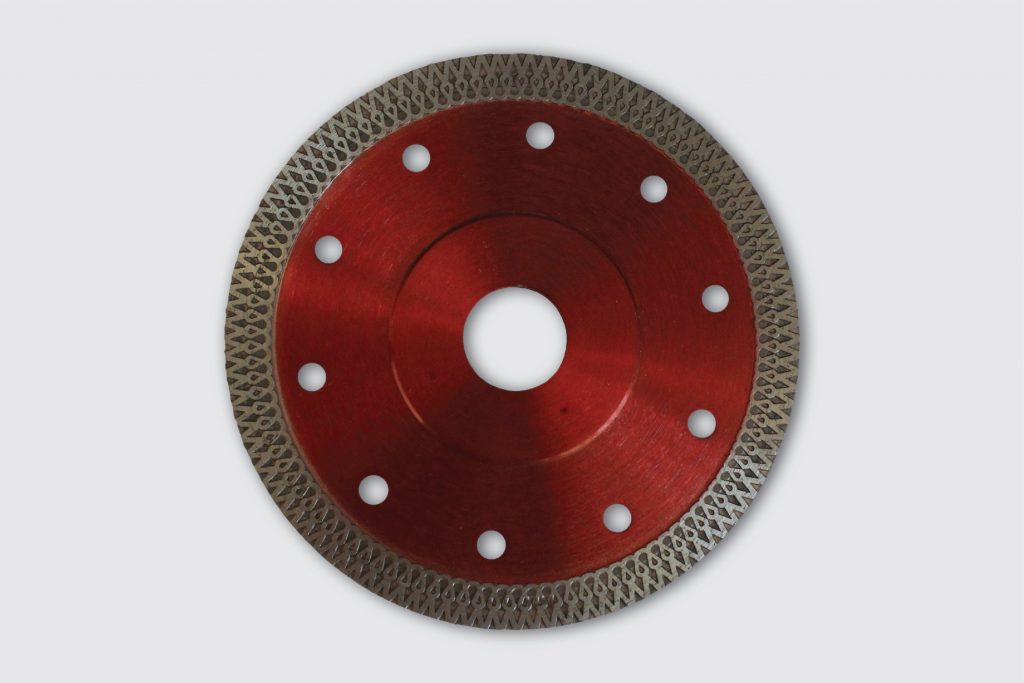
Continuous rim blade
The choice between using a continuous rim blade versus a segmented blade often depends on the material that is going to be cut. A continuous rim blade is designed to cut smoothly into the material, which is particularly important when working with materials like porcelain, ceramic tiles, marble, granite, and other natural stones. The continuous rim, as the name implies, features a solid, uninterrupted edge. This design of blade reduces the likelihood of chipping or spalling (where small pieces break off from the material being cut). This makes continuous rim blades ideal for applications requiring precision and a high-quality finish.
Segmented rim blade

Segmented blades have a rim that is divided into segments separated by gaps. These gaps allow for more air flow and help to keep the blade cool during cutting, which is beneficial for cutting more abrasive materials like concrete and brick. However, the segmented design can result in a rougher cut, and the gaps in the blade make it less suitable for materials like porcelain, which are prone to chipping.
In summary, the choice of a continuous rim blade over a segmented blade for certain materials is driven by the need to minimise spalling and achieve a smooth, precise cut, making it a better choice for a high-quality finish.
How to cut porcelain slabs: the final steps
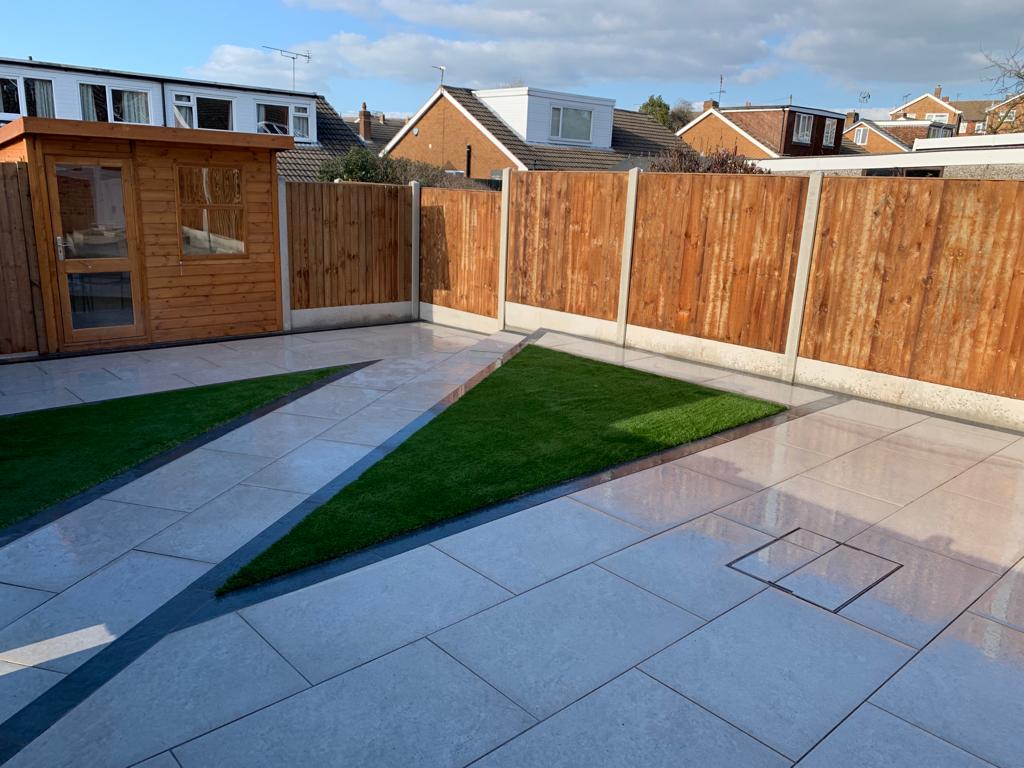
Regardless of the method you've chosen for cutting your porcelain paving slabs, you will next need to chamfer the edges on any tiles that have been cut. If you look at porcelain pavers, you will notice a small chamfer on the edge. This chamfer is added during the manufacturing process to reduce the chance of the edge chipping. When porcelain is cut, the chamfer is removed and so it needs to be re-added. There are a number of different tools you can use to do this.
If you have used an angle grinder or a wet tile saw, you may find that sandpaper or an abrasive wheel is the most effective method.
When you've finished cutting, it's important to clean up and dispose of any tile scraps safely. Once you've inspected your tiles and you're happy with them, you can then start to install them.
At London Stone, we sell a range of cutting tools for customers who want to cut their own paving slabs. Once you’ve cut your slabs to size, you can find out more about how to lay your porcelain slabs.


/filters:quality(60)/mediadev/media/menu-pics/all-porcelain.jpg )
/filters:quality(60)/mediadev/media/menu-pics/luxury-italian.jpg )
/filters:quality(60)/mediadev/media/menu-pics/premium-italian.jpg )
/filters:quality(60)/mediadev/media/menu-pics/budget-porcelain.jpg )
/filters:quality(60)/mediadev/media/menu-pics/large-format-porcelain.jpg )
/filters:quality(60)/mediadev/media/menu-pics/wood-effect-porcelain.jpg )
/filters:quality(60)/mediadev/media/menu-pics/porcelain-planks.jpg )
/filters:quality(60)/mediadev/media/menu-pics/porcelain-setts.jpg )
/filters:quality(60)/mediadev/media/menu-pics/browse-all-paving.jpg )
/filters:quality(60)/mediadev/media/menu-pics/stone-paving.jpg )
/filters:quality(60)/mediadev/media/menu-pics/interior-tiles.jpg )
/filters:quality(60)/mediadev/media/menu-pics/stone-effect-porcelain.png )
/filters:quality(60)/mediadev/media/menu-pics/wood-effect-porcelain.png )
/filters:quality(60)/mediadev/media/menu-pics/grey-porcelain.png )
/filters:quality(60)/mediadev/media/menu-pics/beige-porcelain.png )
/filters:quality(60)/mediadev/media/menu-pics/dark-porcelain.png )
/filters:quality(60)/mediadev/media/menu-pics/light-porcelain.png )
/filters:quality(60)/mediadev/media/menu-pics/patio-grout.jpg)
/filters:quality(60)/mediadev/media/menu-pics/primers.jpg)
/filters:quality(60)/mediadev/media/menu-pics/porcelain-blades.jpg)
/filters:quality(90)/mediadev/media/menu-pics/drainage.jpg)
/filters:quality(60)/mediadev/media/menu-pics/cleaners.jpg)
/filters:quality(60)/mediadev/media/menu-pics/all-stone-paving.jpg )
/filters:quality(60)/mediadev/media/menu-pics/all-sawn-paving.jpg )
/filters:quality(60)/mediadev/media/menu-pics/all-riven-paving.jpg )
/filters:quality(60)/mediadev/media/menu-pics/indian-sandstone.jpg )
/filters:quality(60)/mediadev/media/menu-pics/limestone-paving.jpg )
/filters:quality(60)/mediadev/media/menu-pics/granite-paving.jpg )
/filters:quality(60)/mediadev/media/menu-pics/slate-paving.jpg )
/filters:quality(60)/mediadev/media/menu-pics/yorkstone-paving.jpg )
/filters:quality(60)/mediadev/media/menu-pics/stone-pavers.jpg )
/filters:quality(60)/mediadev/media/menu-pics/cobbles-setts.jpg )
/filters:quality(60)/mediadev/media/menu-pics/plank-paving.jpg )
/filters:quality(60)/mediadev/media/menu-pics/paving-circles.jpg )
/filters:quality(60)/mediadev/media/menu-pics/bespoke-paving-1.jpg )
/filters:quality(60)/mediadev/media/menu-pics/edging-stones-1.jpg )
/filters:quality(60)/mediadev/media/menu-pics/prestige-stone.jpg )
/filters:quality(60)/mediadev/media/menu-pics/grey-blue-stone.png)
/filters:quality(60)/mediadev/media/menu-pics/swatch-black-dark.jpg )
/filters:quality(60)/mediadev/media/menu-pics/swatch-buff-beige-white.jpg )
/filters:quality(60)/mediadev/media/menu-pics/sealants.jpg)
/filters:quality(60)/mediadev/media/menu-pics/all-clay-paving.jpg )
/filters:quality(60)/mediadev/media/menu-pics/alpha-clay-pavers.jpg )
/filters:quality(60)/mediadev/media/menu-pics/cottage-garden-clay-pavers.jpg )
/filters:quality(60)/mediadev/media/menu-pics/kessel-garden-clay-pavers.jpg )
/filters:quality(60)/mediadev/media/menu-pics/artisan-clay-pavers.jpg )
/filters:quality(60)/mediadev/media/menu-pics/grey-blue-clay-paver.png )
/filters:quality(60)/mediadev/media/menu-pics/red-brown-clay-pavers.png )
/filters:quality(60)/mediadev/media/menu-pics/beige-buff-clay-pavers.png )
/filters:quality(60)/mediadev/media/menu-pics/composite-decking.jpg )
/filters:quality(60)/mediadev/media/menu-pics/designboard-decking.jpg )
/filters:quality(60)/mediadev/media/menu-pics/classic-designboard.jpg )
/filters:quality(60)/mediadev/media/menu-pics/brushed-designboard.jpg )
/filters:quality(60)/mediadev/media/menu-pics/grooved-designboard.jpg )
/filters:quality(60)/mediadev/media/menu-pics/millboard-decking.jpg )
/filters:quality(60)/mediadev/media/menu-pics/grey-decking.jpg )
/filters:quality(60)/mediadev/media/menu-pics/black-charcoal-decking.jpg)
/filters:quality(60)/mediadev/media/menu-pics/brown-decking.jpg)
/filters:quality(60)/mediadev/media/menu-pics/all-build-deck.png )
/filters:quality(60)/mediadev/media/menu-pics/stone-cladding.jpg )
/filters:quality(60)/mediadev/media/menu-pics/all-garden-walling-1.jpg )
/filters:quality(60)/mediadev/media/menu-pics/facing-bricks.jpg )
/filters:quality(60)/mediadev/media/menu-pics/garden-screening.jpg )
/filters:quality(60)/mediadev/media/menu-pics/all-steps-coping.jpg )
/filters:quality(60)/mediadev/media/menu-pics/stone-garden-steps.jpg )
/filters:quality(60)/mediadev/media/menu-pics/sawn-steps.jpg )
/filters:quality(60)/mediadev/media/menu-pics/riven-steps.jpg )
/filters:quality(60)/mediadev/media/menu-pics/yorkstone-steps.jpg )
/filters:quality(60)/mediadev/media/menu-pics/bespoke-steps.jpg )
/filters:quality(60)/mediadev/media/menu-pics/porcelain-steps.jpg )
/filters:quality(60)/mediadev/media/menu-pics/off-the-shelf.jpg )
/filters:quality(60)/mediadev/media/menu-pics/stone-coping.jpg )
/filters:quality(60)/mediadev/media/menu-pics/sawn-coping.jpg )
/filters:quality(60)/mediadev/media/menu-pics/riven-coping.jpg )
/filters:quality(60)/mediadev/media/menu-pics/yorkstone-coping.jpg )
/filters:quality(60)/mediadev/media/menu-pics/bespoke-coping.jpg )
/filters:quality(60)/mediadev/media/menu-pics/stone-pier-caps.jpg )
/filters:quality(60)/mediadev/media/menu-pics/porcelain-coping.jpg )
/filters:quality(60)/mediadev/media/menu-pics/all-bespoke-services.jpg )
/filters:quality(60)/mediadev/media/menu-pics/bespoke-paving-2.jpg )
/filters:quality(60)/mediadev/media/menu-pics/bespoke-steps-1.jpg )
/filters:quality(60)/mediadev/media/menu-pics/bespoke-coping-1.jpg )
/filters:quality(60)/mediadev/media/menu-pics/edge-profiles.jpg )
/filters:quality(60)/mediadev/media/menu-pics/masonry-services.jpg )
/filters:quality(60)/mediadev/media/menu-pics/deluxe-pergolas.jpg )
/filters:quality(60)/mediadev/media/menu-pics/proteus-pergolas.jpg )


